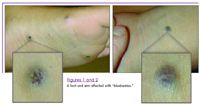Dermatology: What's your Dx? Blueberries on a toddler
A healthy 2-year-old was noted to have "blueberry" spots on her legs and trunk at birth.
Photos are used for illustration purposes only, and may not be of the patient described in the article.
Please see Dr. Cohen's Web site, http://www.dermatlas.org/, for additional images

DIAGNOSIS Blue rubber bleb nevus syndrome
In 1860, Gascoyen reported a case of gastrointestinal (GI) bleeding in a patient with both GI and cutaneous vascular lesions. William Bennett Bean named it blue rubber bleb nevus syndrome (BRBNS).1 BRBNS, or Bean's syndrome, is characterized by skin and GI venous malformations that occasionally affect other organs. The majority of patients acquire it sporadically, but autosomal dominant inheritance of the disease has been reported.2,3
What are the signs and symptoms?
Patients usually present at birth or infancy with numerous blue papules that Bean described as being similar to "rubber nipples," on the extremities, trunk, and face.1 The blebs tend to fall into three categories. Type I is characterized by very large venous lesions. In Type II, the lesions are non-blanching, compressible, and slow to refill after pressure is released. Our patient demonstrates Type III lesions, where 2- to 4-mm blue macules or dome-shaped papules predominate.1 Many of these soft blebs become painful during puberty, especially at night.4 Blebs also become more numerous and larger with age.5 Bleeding can be a problem when lesions receive recurrent trauma.6
Systemic involvement is common. Associated GI venous malformations, usually of the small intestine, may lead to occult or massive bleeding. Blood loss secondary to bleeding can result in iron-deficiency anemia.4 GI venous malformations can also lead to intussusception, volvulus, hemorrhage, infarction, melena, hematemesis, or abdominal pain.1,4 More rarely, venous malformations in the chest can lead to hemothorax, hemoptysis, and hemopericardium. Patients with central nervous system lesions may present with seizures, ataxia, or weakness.1 Thrombosis of brain blebs can result in stroke-like symptoms.
What is the differential diagnosis?
The differential diagnosis of blue papules and macules includes hereditary hemorrhagic telangiectasia (Osler-Weber-Rendu disease), Fabry's disease, multiple glomangiomas, and Maffucci's syndrome.4
In the newborn, it is also important to differentiate the blue lesions in BRBNS from the blueberry muffin-like eruption seen in congenital rubella, cytomegalovirus, toxoplasmosis, or blood dyscrasias. Skin findings in blueberry muffin eruptions include blue, red, or purple non-blanching, firm, macules or papules on the head, neck, and trunk.7 These worrisome blue lesions tend to become tan or brown and eventually fade without intervention, in two to six weeks.7,8 Histologic findings in the blueberry muffin lesions associated with congenital infections usually show extramedullary hematopoiesis.
BRBNS treatment options
Small superficial lesions which bleed or are associated with pain may respond to pulsed dye laser.1 A recent study suggests that etidronate (Didronel), a bisphosphonate, may prevent calcified bleb enlargement and control pain.5 Destructive measures including electrocautery and carbon dioxide laser can be used to ablate symptomatic lesions.
Recognize & Refer: Hemangiomas in pediatrics
July 17th 2019Contemporary Pediatrics sits down exclusively with Sheila Fallon Friedlander, MD, a professor dermatology and pediatrics, to discuss the one key condition for which she believes community pediatricians should be especially aware-hemangiomas.